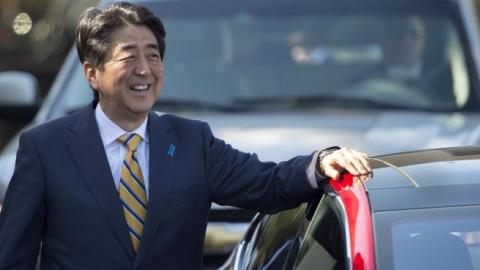Prime Minister Shinzo Abe’s recent visit to the United States was, from his perspective, hugely successful. The first revision in 18 years of the bilateral defense guidelines was concluded, giving Japan’s Self-Defense Forces an expansive role in providing logistical support to the U.S. And U.S. President Barack Obama reaffirmed that the Japanese-administered Senkaku Islands, over which China has attempted to stake its claim, are covered by the mutual-defense treaty. Progress was made on the Trans-Pacific Partnership trade pact, which needs Japan’s buy-in to succeed. And Abe became the first Japanese leader to address a joint session of Congress.
But, despite this impressive list of achievements, the most striking part of Abe’s trip came at the end. Instead of heading home soon after the official part of his visit was over, Abe headed to California, including Silicon Valley, for four days.
According to official Japanese media reports, Abe visited California to gain inspiration and insights to take back to Tokyo. But the California sojourn also sent a strong message: graceful decline is not Japan’s pre-determined path. Under Abe’s leadership, the country will do what it takes to reinvent itself economically, just as the U.S. has done so many times.
Given the potential of expectations to shape real-world developments, via their impact on strategic and political decisions, this strategy makes sense. Abe knows that he must challenge today’s prevailing narrative that Asia’s economic future belongs to China. If he fails, pressure will mount on the region’s governments to align themselves with China geopolitically, potentially even following its lead in choosing prosperity over freedom.
As of now, most East Asian countries seem to hope that Abe succeeds. Indeed, they have cautiously backed Japan as an essential counterweight to a rising China — and with good reason. Whereas China’s regional economic importance tends to be overestimated, Japan is often underrated.
In reality, Chinese trade within Asia — for example, with the members of the Association of Southeast Asian Nations (ASEAN) — is carried out largely by firms with parent companies from advanced economies, including Japan. Moreover, despite China’s reputation as the more dynamic growth market, Japanese consumers still have far deeper pockets than their Chinese counterparts, meaning that Japan plays a greater role in sustaining the region’s export-dependent economies.
Asia’s developing economies, including China, cannot reach their potential without foreign capital and innovation — something that advanced economies like Japan provide. Indeed, Japan provides far more foreign direct investment than China in every major economy in Southeast Asia and ASEAN as a whole, and its leading firms — global players such as Mitsubishi and Sony — transfer far more technology and know-how to developing Asia than their Chinese counterparts.
To be sure, China is working hard to catch up, with the government having identified entrepreneurship and innovation as essential to the evolution of the country’s growth model. But when it comes to advanced technologies in emerging sectors like next-generation computing and energy systems, as well as developments in manufacturing like robotics and 3D printing, Japan’s considerable lead should not be underestimated.
Still, Japan will have to work hard to avoid losing its advantage. That will mean undertaking difficult structural reforms, such as the liberalization of industrial relations. Fortunately, Abe recognizes this imperative, and the third “arrow” of his strategy to reinvigorate Japan’s economy has established it as an official goal, (together with opening up protected sectors — particularly agriculture — to greater external competition).
Of course, there is no guarantee that the structural-reform phase of “Abenomics” will succeed. What is certain is that China faces an even more daunting challenge: it must reinvent, not just reform, its political economy.
Despite achieving three decades of rapid economic growth, China still functions on Cold War-era institutional hardware. The kind of large-scale innovation occurring in advanced economies requires institutions that ensure the rule of law, intellectual property rights and a genuine meritocracy, with the most deserving firms, not those favored by the state, having access to the funding and opportunities they need to grow. In this respect, China still has a long way to go.
Japan was never out of the contest to shape Asia’s future economic order. (As one-half of the alliance that will play the largest role in defining the East Asian balance of power in the coming decades, Japan will also play a vital strategic role.) But Abe’s recent trip to the U.S. served as an important reminder of Japan’s centrality to Asian affairs.
It is somewhat ironic that, as the world gears up to commemorate the 70th anniversary of Japan’s defeat in World War II, the governments of the U.S. and almost every major Asian country are quietly cheering for Abe. What Japan is fighting for this time promises to bring far-reaching benefits, in Asia and beyond.

















